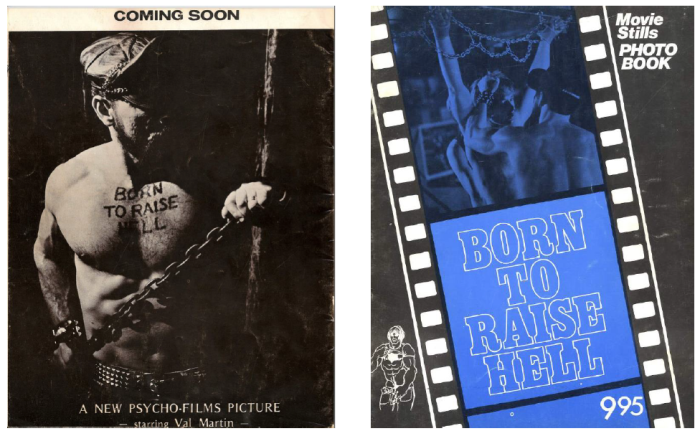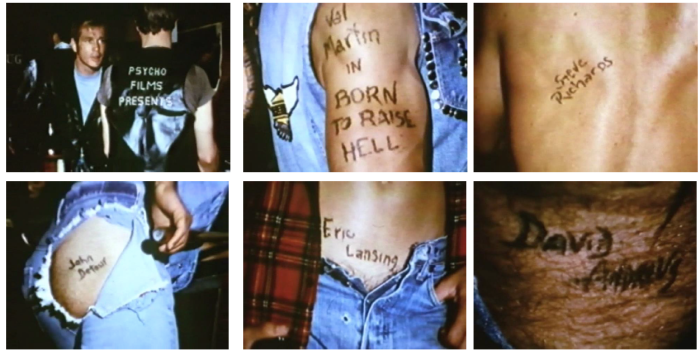by Gary Needham, University of Liverpool, UK
The 1974 film Born to Raise Hell was described by gay porn pioneer Fred Halstead as the best SM film he had ever seen and, more recently, by its current distributor as ‘the standard, the ultimate classic BDSM movie that all gay BDSM films are judged’. Rarely seen since the 1970s, the film was largely undocumented with the exception of Jack Fritscher’s interview with the film’s director Roger Earl in 1997 and has only recently seen the light of day. [1] My own interest in the film is around gay sexual cultures of the 1970s and the contiguous formal and political relations in representations of gay SM. This is also an attention to formal and sexual relations and the question of how sex is edited and, in turn, what (now) also gets ‘edited out’ through various cultural, political and legal policing in both representation and discourse. I want to claim Born to Raise Hell as an instance in which one can reassert the outlaw politics of homosexuality vis-à-vis contemporary queer theory, which, Tim Dean suggests, has become one of ‘institutional respectability by strategically distancing itself from the messiness of the erotic’. [2] Politically, we need to reassert the erotic in queer studies if it is to have any meaning for our actually lived lives. Recovering Born to Raise Hell from the 1970s seems to me a useful place to start ‘thinking sex’ again.

Born to Raise Hell raises some crucial ontological questions around film form, spectatorship and sex in ways that one might think of as proto-queer, affirmatively sadomasochistic but overtly essentialist too. The dilemma is that queer is a committedly anti-essentialist practice. Yet we need at times to be essentialist to achieve a certain political efficacy [3] and even a certain acknowledgment of existence in the matters of sex that, frankly, queer theory can’t quite come to terms with these days. Conference after conference, queer theory or queer studies remains a sexless and, it should also be noted, AIDS-less affair. But we have been here before. The 1970s liberation-era publication Gay Sunshine declared ‘we should cultivate a strong sense of dignity about our person, our bodies, rid ourselves of the repressive sexual habits which kept us down in filth – masochism… and sadism… sexual freedom is not freedom to degrade oneself’. [4] The difficulty in dealing with ‘the messiness of the erotic’ is already in place before the contemporary queer demonstrates its own intellectually icky-ness and sex-aversive abstinence, which now extends to the erasure of AIDS and HIV from its list of conference-able topics.
Following a disclaimer about SM, the first few minute of Born to Raise Hell is a montage of shots of leather caps, motorcycle boots, aviator shades, leather cuffs, a red handkerchief, zooming out from close-ups of bodies to reveal a bar-room setting. Much of this assembly of shots is a knowing reference to Scorpio Rising (Kenneth Anger 1964) but also, we should note, a porn film exemplary in its clever use of editing. The montage in Born to Raise Hell continues and introduces a few credits written directly on the men’s bodies or studded upon their denim waistcoats. The opening shots/credits transition to a shot that zooms out to reveal one man urinating into the mouth of another. The bar space, the men’s bodies, the credits, the piss, the lack of comprise, seems abrupt and shattering in its directness. The dissolution of space, bodies, credits and sex – the organisation of relatedness of both the formal and the sexual – ask us to ‘think sex’ both cinematically and subculturally in ways that were radical. Is it like a different kind of cut, one that cuts into the safety of spectatorship, the safety of contemporary queer praxis, the safety even of conventional pornographic staging to at least offer a way in to kink.

What can we learn from Born to Raise Hell? What can we learn from those queers or anyone for that matter who might find it oddly intolerable, not just straight-forwardly abject or incomprehensible, but intolerable of the film’s other heavy SM scenes; a shattering impulse that ebbs at the fragility of the ego, of our self and relation with the world in the witnessing of the body’s surrender to a pleasurable annihilation and its administration? These questions would seem to be about finding the meaningful connections between erotic relations and formal relations. An aesthetics as a way of relating to the world might be a way in which to see the value of this particular film’s radical, erotic ontology as also doing some kind of political work that, in bringing it forward to the now, challenges the current state of a queer theory without sex, of a queer theory without homosexuals.
I have already been hinting in a language and posturing that evokes Leo Bersani. There is something to say about the difficulty of Bersani’s work as an ally for the difficulty of the screen sex I’m championing here and the flavour of approach indebted to thinking alongside Bersani, since one does not simply apply Bersani. The possibility of some sex being an experience that shatters rather than keeps one together is a fundamentally Bersanian trope. To take one to the edge of their very existence as a coherent subject – Bersani would also call it a self-divestiture – is, of course, problematic for identity politics because it is about undoing identity itself, giving it up, refusing to be mastered by one’s own sense of the self. And not just the self but relations with others too are subject to shattering and disconnection. Bersani’s critique of queer theory in Homos (1996) is rendered as the problem of the homosexual, which is also the problem of the erotic, the problem of intolerable sex, the problem of what gay men do. Queer theory’s millennial shift towards, not a thinking sex but a thinking world, may in fact have the reverse effect of its original intentions. In championing the de-sexed, fluid, flexi-pronoun loving, anti-essentialist queer, the homosexual is eradicated. This is exactly the point of Bersani’s opening sentence in Homos in which he writes ‘no one wants to be called a homosexual’ and in a few pages later that ‘de-gaying gayness can only fortify homophobic oppression; it accomplishes in its own way the principal aim of homophobia: the elimination of gays’. [5] Therefore, is queer studies homophobic?

Back to Hell. The hell-raising approach to sex and refusal of the assimilationist niceties, Born to Raise Hell and its men’s outlaw nature is literally embodied as the credits are slowly revealed on their bodies and studded jackets as a sort of frank materiality of the gay body’s place in a setting that is defined by its overlap of sociality and sexuality (the bar as a place to socialise but also to have sex). The film credits are not outside the text but incorporated into the body of the performers, the body of the film, as a sort on ontological register. This isn’t just a movie, just a porno, but a representation of a living community. For us, now, an archival text. Two minutes in and the final montage-credit zooms out to that first scene pissing that cuts, playfully, obviously, to a bottle of beer being poured. It is a match cut; such a smart gesture towards the language of cinema not just the Scorpio Rising montage that precedes it but also 2001: A Space Odyssey (Stanley Kubrick 1968). This match cut is ground in the sociality and sexuality of the bar.
What I am also trying to eventually think through are the possibilities in the overlapping of sociability, sexuality and film form. That is, the relatedness of certain subjectivities in screen sex and the relatedness of specific formal and editing patterns that I also see more recently in a film like Theo and Hugo (Olivier Ducastel and Jacques Martinez 2016) and its potent and overtly gay male opening sequence of ‘real sex’. Sociality or sociability is, again, a concept that Bersani introduces to us. [6] From the pissing to the beer bottle, the match cut is here on a continuum of erotic practice, social practice and formal practice both social and sexual, intimate and shared. The match cut’s basic premise of graphic similarity between shots is not in the service of classical continuity, rather, it is in the service of understanding the relationship between the sexual and the social that exists in some aspects of gay life and culture. While a match cut is about causation in the conventional sense, here it is the causation between sexuality and sociality or the lack of separation between the two, like the merging of the credits and the bodies, a representation of the literal film body of gay cinema and the lived social spaces and practices of the men it documents. The civilising leap of 2001’s match cut is here appropriated as some kind of statement of SM pride that ‘we have arrived’ and we’re not afraid to show it! Such a gesture around ‘the art of pissing’ [7] is perhaps needed to wake up queer studies from its own relation to the world of its making, one in which there is a lot of homosexuality but frankly, no homosexuals.
Notes
[1] See Marco Seidelmann and Jack Fritscher 2016. California Dreamin’: West Coast Directors and the Golden Age of Forbidden Gay Movies. Paris: Editions Moustache.
[2] Tim Dean 2015a. ‘No Sex Please, We’re American’. American Literary History, 27(3), 616.
[3] See Gayatri Spivak 1988. ‘Subaltern Studies: Deconstructing Historiography’. In Ranajit Guha and Gayatri Chakravorty Spivak eds. In Other Worlds: Essays in Cultural Politics. Oxford: Oxford University Press, 197-221.
[4] Patrick Moore 2004. Beyond Shame: Reclaiming the Abandoned History of Gay Sexuality. New York: Beacon Press, 18.
[5] Leo Bersani 1996. Homos, Harvard University Press, 1, 5.
[6] See Leo Bersani 2000. ‘Sociality and Sexuality’. Critical Inquiry 26(4), 641-656; Leo Bersani 2002. ‘Sociability and Cruising’. Umbr(a) 1, 9-23.
[7] Tim Dean 2015b. ‘The Art of Piss’. Animal Shelter 4, 121-129.
Contributor

Gary Needham is Senior Lecturer in Film and Media at The University of Liverpool. His research cuts across film, television and contemporary art; sex and sexuality has featured strongly in a lot of that work. He is the co-editor of volumes on Asian Cinemas (2006), Queer TV (2009) and Warhol in Ten Takes (2013), a monograph on the film Brokeback Mountain (2010), and is co-editor of two book series: American Indies (Edinburgh University Press) and Hollywood Centenary (Routledge). He is currently working on a new monograph on Andy Warhol and his collaborative relationship with Edie Sedgwick (Bloomsbury) and other research that explores sex and film form in contemporary gay cinema.
gary.needham@liverpool.ac.uk / gary_needham

It’s the first gay xxx that I watched as a film and not a prurient thrill; it certainly made an impression.
LikeLike